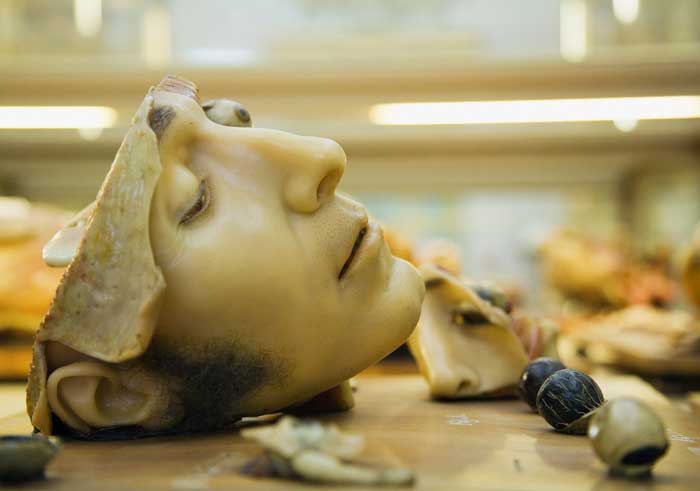
When I was working on my photographic exhibition Anatomical Theatre, I looked everywhere in an attempt to find writers or critics who discussed artworks inspired by medical museums, anatomical models, and preserved human specimens. In all my searching, I came across only one writer, thanks to my good friend Matt Haber, who sent his book my way; his name is Mark Dery, and you might remember from this recent Morbid Anatomy post.
In his book The Pyrotechnic Insanitarium: American Culture on the Brink
 , Dery explores this topic in three essays comprising the section "Dead Meat," the most directly medical-museumy of which is the wonderful essay "Nature Morte: Formaldehyde Photography and the New Grotesque." The good news is that Mark just linked from his Shovelware blog to a free, down-loadable PDF of the essay, images included! I highly recommend giving this essay--if not the entire book--a read. The essays are full of fascinating information compellingly related to artists whose work lies in the realm of--in Dery's memorable phrase--the "Pathological Sublime."
, Dery explores this topic in three essays comprising the section "Dead Meat," the most directly medical-museumy of which is the wonderful essay "Nature Morte: Formaldehyde Photography and the New Grotesque." The good news is that Mark just linked from his Shovelware blog to a free, down-loadable PDF of the essay, images included! I highly recommend giving this essay--if not the entire book--a read. The essays are full of fascinating information compellingly related to artists whose work lies in the realm of--in Dery's memorable phrase--the "Pathological Sublime."More about the essay, from the description on his blog post:
In "Nature Morte: Formaldehyde Photography and the New Grotesque," a chapter from his meditation on the millenial zeitgeist, The Pyrotechnic Insanitarium: American Culture on the Brink (Grove/Atlantic: 1999), cultural critic Mark Dery analyzes the abject aesthetic he calls the New Grotesque, exemplified by the photography of Joel-Peter Witkin and Rosamond Purcell, Nine Inch Nails videos such as "Closer," David Fincher's movie Seven, and most notably the obscure subculture of medical-museum tourists whose mecca is the Mutter Museum in Philadelphia. "If the Enlightenment ushered in the 'disenchantment of the world,' as Max Horkheimer and Theodor Adorno put it, postmodernism returns us to the age of wonder---and terror," writes Dery. "Now, as we return to a world of gods and monsters, there's a burgeoning fascination, on the cultural fringes, with congenital deformities, pathological anatomy, and other curious from the cabinet of wonder."You can see Dery's original post by clicking here. You can access the PDF directly by clicking here. You can buy a copy of the book by clicking here.
Drawing on Lawrence Weschler's study of the Museum of Jurassic Technology (Mr. Wilson's Cabinet of Wonder), Gwen Akin and Allan Ludwig's seminal essay "Repulsion: Aesthetics of the Grotesque," Julia Kristeva's notion of the abject, Wolfgang Kayser's landmark study of the grotesque, and Oliver Wendell Holmes's 1845 paean to "worshippers of morbid anatomy," Dery theorizes the Pathological Sublime, an aesthetic emotion that is equal parts horror and wonder, inspired by works of art (or nature) that hold beauty and repulsion in perfect, quivering tension. The Pathological Sublime is the sensation Emily Dickinson had in mind when she wrote, "'Tis so appalling---it exhilarates..."
Image: From Anatomical Theatre. Museum of Anatomical Waxes “Luigi Cattezneo” (Museo Delle Cere Anatomiche “Luigi Cattaneo”): Bologna, Italy; Wax model of the eye apparatus and related structures; Clemente Susini, late 18th or early 19th Century


2 comments:
thank you for the link...sounds fascinating (and I've been reading way too much fluff fiction recently anyway).
Rosamond Purcell's latest book, Egg & Nest published in Fall 2008 by Harvard University Press (by whom I'm employed) and there's a lovely slide show available of many images from the book:
http://www.hup.harvard.edu/features/puregg/
Enjoy!
Post a Comment